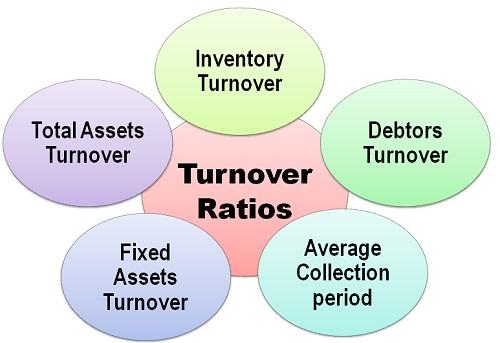Turnover Ratio
Turnover Ratios draw attention to the diverse aspects of financial statement to meet the requirements of different parties interested in the business. It also underlines the efficiency with which different assets are vitalized in a business. Turnover means the number of times assets are converted or turned over into sales. The activity ratios indicate the rate at which different assets are turned over.
The following activities or turnover ratios can be calculated:
- Inventory Ratio or Stock Turnover Ratio
- Debtor’s Turnover Ratio or Receivable Turnover Ratio
- Debtor’s Collection Period Ratio
- Creditor’s Turnover Ratio or Payable Turnover Ratio
- Working Capital Turnover Ratio
- Fixed Assets Turnover Ratio
- Capital Turnover Ratio.
Inventory Ratio or Stock Turnover Ratio
It is used to measure whether the investment in stock in trade is effectively utilized or not. It
reveals the affiliation between sales and cost of goods sold or average inventory at cost price or
average inventory at selling price. It indicates the number of times the stock has been turned over in
business during a particular period.
| Stock Turnover Ratio = Cost of Goods Sold / Average Inventory at Cost |
|---|
Debtors Turnover Ratio
This ratio indicates the efficiency of the debt collection period and the extent to which the debt
have been converted into cash. This ratio is complementary to the Debtor Turnover Ratio. It is very
helpful to the management because it represents the average debt collection period
| Debtors Turnover Ratio = Net Credit Sales / Average Receivables |
|---|
Debt Collection Period Ratio
This ratio highlights the competence of the debt collection period and the magnitude to which the
debt have been converted into cash. This ratio is corresponding to the Debtor Turnover Ratio. It
plays an instrumental to the management because it denotes the average debt collection period.
| Debt Collection Period Ratio = Receivables x Months or days in a year / Net Credit Sales for the year |
|---|
Creditor’s Turnover Ratio or Payable Turnover Ratio
Payable Turnover Ratio is also termed as Creditor’s T.R or Creditor’s Velocity. The credit
purchases are recorded in the accounts of the buying companies as Creditors to Accounts Payable.
The Term Accounts Payable or Trade Creditors comprise of sundry creditors and bills payable.
This ratio corroborates the relationship between the net credit purchases and the average trade
creditors. Creditor’s velocity ratio underlines the number of times with which the payment is made
to the supplier apropos to credit purchases.
| Creditor’s Turnover Ratio = Net Credit Purchases / Average Accounts Payable |
|---|
Working Capital Turnover Ratio
The effective employment of working capital pertaining to sales is indicated by this ratio. This ratio
signifies the firm’s liquidity position. It institutes relationship between cost of sales and networking
capital.
| Working Capital Turnover Ratio = Net Sales / Working Capital |
|---|
Fixed Asset Turnover Ratio
This ratio indicates the efficiency of assets management. Fixed Assets T.R is put to
application to gauge the optimum utilization of fixed assets. This ratio forms the liaison between
cost of goods sold and total fixed assets. Underutilization of fixed assets is demonstrated, if the ratio
is depressed.
| Fixed Asset Turnover Ratio = Cost of goods Sold / Total Fixed Assets |
|---|
Capital Turnover Ratio
This ratio measures the efficiency of capital utilization in the business. It illustrates the relationship
between cost of sales or sales and capital employed or shareholders’ fund.
| Capital Turnover Ratio = Cost of goods Sold / Total Fixed Assets |
|---|

